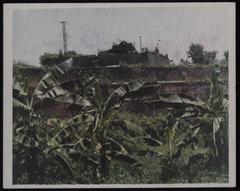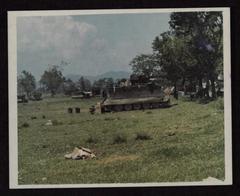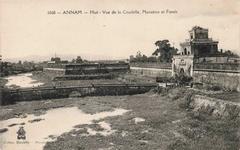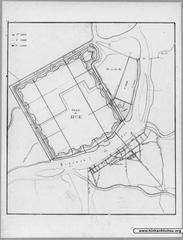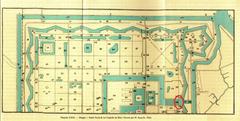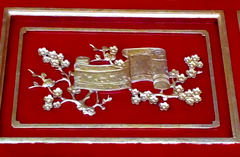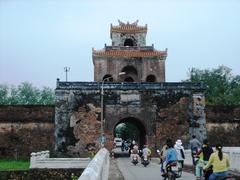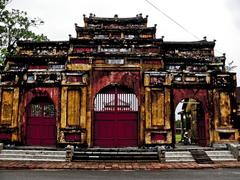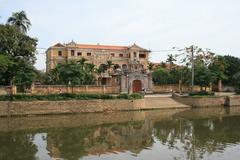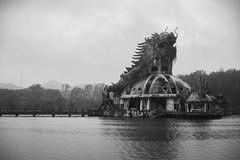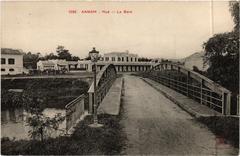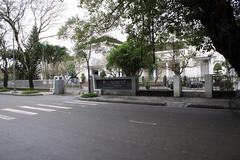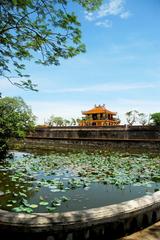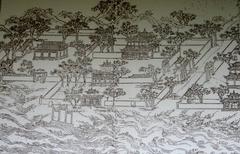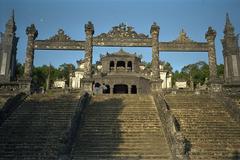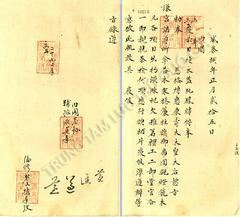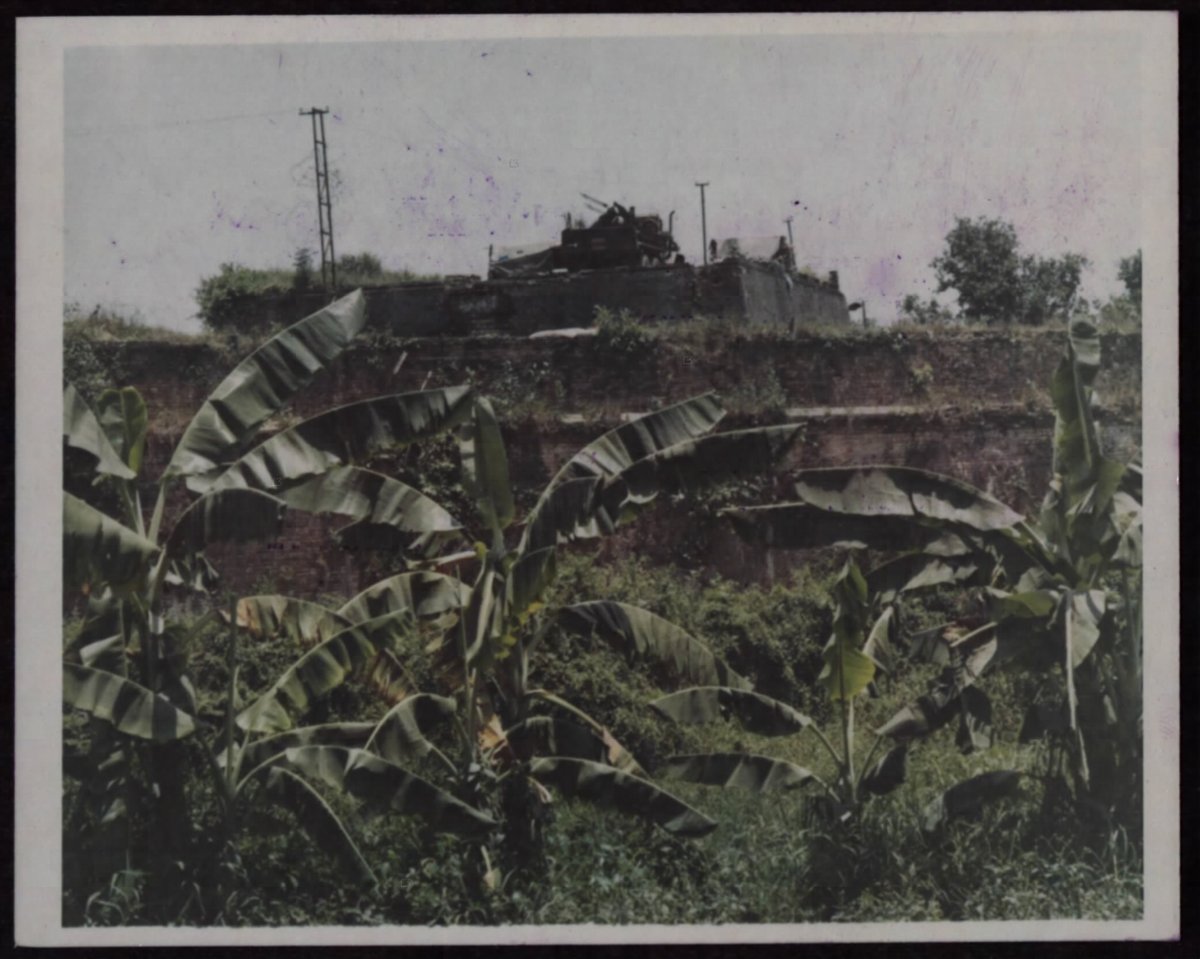
Huế Citadel Visiting Hours, Tickets, and Historical Sites Guide
Date: 14/06/2025
Introduction
Nestled on the banks of the Perfume River in central Vietnam, the Huế Citadel stands as an enduring symbol of the country’s imperial grandeur and rich cultural heritage. Constructed in the early 19th century as the seat of the Nguyễn dynasty, the Citadel’s vast and intricate complex embodies the fusion of Confucian ideals, indigenous artistry, and strategic military design. Designated a UNESCO World Heritage Site in 1993, Huế Citadel draws visitors worldwide eager to explore its ornate palaces, imposing gates, sacred temples, and tranquil gardens. This comprehensive guide provides detailed information on Huế Citadel visiting hours, ticketing, accessibility, travel tips, and the historical and cultural context that makes the site a must-visit destination in Vietnam (Planet Travel Advisor; Vietnam Tourism; The Smart Local).
Contents
- Historical Overview: Construction, Decline, and Restoration
- Architectural Layout and Symbolism
- Key Sites and Must-See Attractions
- Visiting Huế Citadel: Hours, Tickets, and Accessibility
- Travel Tips and Visitor Etiquette
- Guided Tours and Cultural Experiences
- Nearby Attractions in Huế
- Frequently Asked Questions (FAQ)
- Conclusion and Additional Resources
Historical Overview
Early Foundations and Construction
The Huế Citadel, or Kinh thành Huế, was established as the political and cultural heart of the Nguyễn dynasty. Construction began in 1803 under Emperor Gia Long, strategically selecting a site along the Perfume River for its defensive and aesthetic value (Planet Travel Advisor; You in Danang). Inspired by both Eastern geomancy and Western Vauban-style fortifications, the Citadel features massive ramparts, a wide moat, and bastions. By 1833, Emperor Minh Mạng expanded the complex to its grand scale, cementing its role as Vietnam’s administrative and ceremonial nucleus (Wikipedia; Rubicon Tours).
Colonial Era, War, and Restoration
Following the French protectorate’s establishment in the late 19th century, the Citadel’s political importance waned, although it retained ceremonial roles (Wikipedia). The abdication of Emperor Bảo Đại in 1945 and subsequent wars led to extensive destruction, notably during the 1968 Battle of Huế. Since the 1990s, robust restoration efforts—bolstered by UNESCO recognition—have preserved and revived the site’s unique architecture and historical significance (Planet Travel Advisor; Rubicon Tours; whc.unesco.org).
Architectural Layout and Symbolism
The Huế Citadel’s design reflects deep symbolic meaning and hierarchical order, with three concentric enclosures:
- Kinh Thành (Capital Citadel): The outermost defensive wall, encircling the administrative and residential quarters.
- Hoàng Thành (Imperial City): The middle enclosure, home to palaces, temples, and ceremonial spaces.
- Tử Cấm Thành (Forbidden Purple City): The innermost area, strictly reserved for the emperor and royal family, modeled after Beijing’s Forbidden City (Wikipedia; hoiantravel.com.vn).
The layout was guided by geomantic (feng shui) principles, with the Perfume River to the south and protective mountains to the north, ensuring harmony between built and natural environments (whc.unesco.org). Ramparts stretch nearly 10 kilometers in length, standing up to 6.6 meters high and 21 meters thick, punctuated by intricately decorated gates (vn-tourism.com; afuncouple.com).
Key Sites and Must-See Attractions
Ngo Mon Gate (Noon Gate)
The iconic southern gateway, reserved for imperial processions, features a multi-tiered structure and the Five Phoenix Watchtower. It serves as the main entrance for modern visitors and a prime photo location (vmtravel.com).
Thai Hoa Palace (Hall of Supreme Harmony)
The ceremonial heart of the Imperial City, renowned for its lacquered columns, dragon motifs, and the imperial throne. The palace hosted coronations and major state events (hoiantravel.com.vn; vmtravel.com).
Forbidden Purple City (Tử Cấm Thành)
Though much was lost during wartime, visitors can explore restored sections, tranquil gardens, and remnants of the emperor’s private quarters. Notable sites include Can Chanh Palace, Can Thanh Palace, and the Royal Theatre (afuncouple.com; thecrazytourist.com).
To Mieu Temple Complex and Nine Dynastic Urns
A sacred site for ancestor worship, featuring ornate architecture and the monumental bronze urns symbolizing the dynasty’s longevity (touringhighlights.com).
Hien Lam Pavilion, Halls of the Mandarins, and Royal Theatre
Explore the tallest pavilion in the Citadel, richly decorated halls, and the Duyệt Thị Đường Royal Theatre—home to UNESCO-listed Vietnamese court music (thecrazytourist.com).
Gardens, Courtyards, and Ruins
The lush gardens, lotus ponds, and evocative ruins offer peaceful retreats and glimpses into the Citadel’s grandeur (thesmartlocal.com).
Visiting Huế Citadel: Hours, Tickets, and Accessibility
Opening Hours
- Summer (May–September): 6:30 a.m. – 5:30 p.m.
- Winter (October–April): 7:00 a.m. – 5:00 p.m.
- Night Tours: On select evenings, the Citadel is illuminated and open for night visits, especially during festivals (Asia Pioneer Travel).
Ticket Prices
- Standard adult: 200,000–250,000 VND (approx. $8.80–$10.80 USD)
- Children under 1.3m: 40,000 VND
- Children under 6: Free
- Combo ticket (Citadel + major tombs): 400,000 VND (approx. $17.30 USD)
- Tickets are available at the main gate, authorized counters, and through the official website (Thaiest; The Smart Local).
Accessibility & Facilities
- Wheelchair access is available in key areas; some historic buildings may have steps or uneven terrain.
- Electric shuttles operate within the Citadel for a small fee.
- Restrooms, refreshment stalls, souvenir shops, and maps are provided throughout the grounds.
- Main entrance: 23 tháng 8 Street, Thuận Hòa Ward (The Smart Local).
Travel Tips and Visitor Etiquette
- Dress Code: Wear modest attire covering shoulders and knees, especially in temples (Asia Pioneer Travel).
- Footwear: Comfortable walking shoes are essential.
- Weather: Bring sun protection, a hat, and a reusable water bottle. Rain gear is advisable September–December.
- Photography: Allowed in most areas; check restrictions in temples or interiors. Early morning or late afternoon offers the best light.
- Cash: Carry Vietnamese Dong for tickets and purchases.
- Respectful Conduct: No smoking, littering, or loud behavior inside the Citadel.
Guided Tours and Cultural Experiences
- Guided Tours: Local guides are available on-site or via agencies, providing insights into the Citadel’s history and architecture (Asia Pioneer Travel; Then We Walked).
- Audio Guides: Rentable at the entrance in multiple languages.
- Cultural Performances: Witness Nhã nhạc (royal court music), changing of the guards, and traditional dance during festivals (Then We Walked).
- Costume Rental: Visitors can rent imperial costumes for memorable photos.
Nearby Attractions in Huế
After your tour of the Citadel, consider exploring:
- Royal Tombs: Minh Mạng, Khải Định, and Tự Đức tombs along the Perfume River (thecrazytourist.com).
- Thien Mu Pagoda: A 17th-century riverside pagoda, 4 km from the Citadel (vietnamnomad.com).
- Dong Ba Market: For local crafts, cuisine, and souvenirs.
Frequently Asked Questions (FAQ)
Q: What are Huế Citadel’s opening hours?
A: 6:30 or 7:00 a.m. to 5:30 p.m., depending on the season. Night tours are available on select dates.
Q: How much are tickets and where can I buy them?
A: Adult tickets are 200,000–250,000 VND. Children under 1.3m pay 40,000 VND; children under 6 are free. Combo tickets are 400,000 VND. Purchase at the gate or online via the official website.
Q: Is the Citadel accessible for those with mobility issues?
A: Some areas have ramps and shuttles, though not all buildings are fully accessible.
Q: Are guided tours available?
A: Yes, both on-site and through agencies, as well as audio guides.
Q: Is photography allowed?
A: Generally yes, but follow posted restrictions in sacred or restored interiors.
Visuals and Media Recommendations
For a richer experience, seek out images and virtual tours featuring:
- Ngo Mon Gate at sunrise
- Thai Hoa Palace interiors
- Forbidden Purple City ruins
- Nighttime festival illuminations
Alt text should utilize keywords such as “Huế Citadel,” “Imperial City Huế,” and “Ngo Mon Gate” for optimal accessibility and searchability.
Conclusion
The Huế Citadel is a living testament to Vietnam’s imperial history, cultural resilience, and architectural mastery. With its grand palaces, sacred temples, evocative ruins, and vibrant festivals, it offers an immersive journey into the past. Careful planning—considering hours, tickets, and accessibility—ensures a fulfilling visit. For current updates, ticket bookings, and personalized itineraries, consult the official website or download the Audiala app.
Additional Resources and Official Links
- Planet Travel Advisor
- Wikipedia: Imperial City of Huế
- Rubicon Tours
- Travel with Minh
- You in Danang
- vn-tourism.com
- hoiantravel.com.vn
- whc.unesco.org
- History Hit
- The Smart Local
- Asia Pioneer Travel
